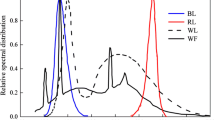Abstract
The impact of illumination on specific growth rate, biomass formation, and synthesis of photopigment was studied in Erythromicrobium hydrolyticum, an obligately aerobic heterotrophic bacterium having the ability to synthesize bacteriochlorophyll a. In dark-grown continuous cultures the concentration of protein increased with increasing dilution rate, the concentration of bacteriochlorophyll a showed the opposite effect. At a dilution rate of 0.08 h-1 (68% of μmax in the dark) and SR-acetate of 11.8 mM, the concentration of BChla of illuminated cultures in steady-state was 11–22 nM, compared to 230–241 nM in cultures incubated in darkness. No significant differences were observed in the concentration of protein. A shift from darkness to light conditions resulted in increased specific growth rates resulting in increased biomass formation, thus showing that light enhances growth by serving as an additional energy source. This phenomenon, however, was temporary because bacteriochlorophyll synthesis is inhibited by light. In contrast to incubation in continuous light or dark, incubation under light/dark regimen resulted in permanently enhanced biomass formation. In the dark periods, bacteriochlorophyll was synthesized at elevated rates (compared to constant darkness), thus compensating the inhibitory effect of light in the preceding period. It thus appears that the organism is well-adpated to life in environments with alternating light/dark conditions. The ecological relevance of the observations is discussed.
Similar content being viewed by others
Abbreviations
- BChla :
-
bacteriochlorophyll a
- D:
-
dilution rate
- μ:
-
spceific growth rate
- Ks :
-
saturation constant
- SR :
-
concentration of limiting in inflowing medium of chemostat
References
Beeftink HH, Gemerden Hvan (1979) Actual and potential rates of substrate oxidation and product formation in continuous cultures of Chromatium vinosum. Arch Microbiol 121: 161–167
DeBont JAM, Scholten A, Hansen TA (1981) DNA-DNA hybridization of Rhodopseudomonas capsulata, Rhodopseudomonas sphaeroides and Rhodopseudomonas sulfidophila strains. Arch Microbiol 128: 271–274
DeWit R, Gemerden Hvan (1990) Growth of the phototrophic purple sulfur bacterium Thiocapsa roseopersicina under oxic/anoxic regimens in the light. FEMS Microbiol Ecol 73: 69–76
Doi M, Shioi Y, Gad'on N, Golecki JR, Drews G (1991) Spectroscopical studies on the light-harvesting pigment-protein complex II from dark-aerobic and light-aerobic grown cells of Rhodobacter sulfidophilus. Biochim Biophys Acta 1058: 235–241
Drews G (1988) Effect of oxygen partial pressure on formation of the bacterial photosynthetic apparatus. In: Acker H (ed) Oxygen sensing in tissues Springer, Berlin Heidelberg New York, p 3–11
Gerritse J, Schut F, Gottschal JC (1992) Modelling of mixed chemostal cultures of an aerobic bacterium, Comamonas testosteroni and an anaerobic bacterium, Veillonella alcalescens. Appl Environ Microbiol 58: 1466–1476
Gottschal JC, Thingstad TF (1982) Mathematical description of comptetition between two and three bacterial species under dual substrate limitation in the chemostat: a comparison with experimental data. Biotechnol and Bioeng XXIV: 1403–1418
Hansen TA (1974) Sulfide als electrondonor voor Rhodospirillaceae. Ph.D. Thesis, University of Groningen, Faculty of Life Sciences
Harashima K, Hayasaki J, Ikari T, Shiba T (1980) O2-stimulated synthesis of bacteriochlorophyll and carotenoids in marine bacteria. Plant Cell Physiol 21: 1283–1294
Harashima K, Kawazoe K, Yoshida I, Kamata H (1987) Light-stimulated aerobic growth of Erythrobacter species OCh114. Plant Cell Physiol 28: 365–374
Hempfling WP, Vishniac W (1967) Yield coefficients of Thiobacillus neapolitanus in continuous culture. J Bacteriol 93: 874–878
Kuenen JG (1979) Growth yields and “Maintenance Energy Requirements” in Thiobacillus species under energy limitation. Arch Microbiol 122: 183–188
Liebetanz R, Hornberger U, Drews G (1991) Organization of the genes coding for the reaction-centre K and M subunits and B870 antenna polypeptides α and β from the aerobic photosynthetic bacterium Erythrobacter species OCH114. Mol Microbiol 5: 1459–1468
Lowry OH, Rosenbrough NJ, Farr AL, Randall RJ (1951) Protein measurements with the Folin phenol reagent. J Biol Chem 193: 265–275
Nanninga HJ, Gottschal JC (1985) Amino acid fermentation and hydrogen transfer in mixed cultures. FEMS Microbiol Ecol 31: 261–269
Mas J, Gemerden Hvan (1987) Influence of sulfur accumulation and composition of sulfur globule on cell volume and buoyant density of Chromatium vinosum. Arch Microbiol 146: 362–369
Pirt SJ (1975) Principles of microbe and cell cultivation. Blackwell, Oxford
Shiba T, Harashima K (1986) Aerobic photosynthetic bacteria. Microbiol Sciences 3: 376–378
Shiba T, Shioi Y, Takamiya K, Sutton D, Wilkinson C (1991) Distribution and physiology of aerobic bacteria containing bacteriochlorophyll a on the East and West coasts of Australia. Appl Environ Microbiol 57: 295–300
Stal LJ, Gemerden Hvan, Krumbein WE (1984) The simultaneous assay of chlorophyll and bacteriochlorophyll in natural microbial communities. J Microbiol Methods 2: 295–306
Widdel F, Pfennig N (1981) Studies on dissimilatory sulfate reducing bacteria that decompose fatty acids. I. Isolation of new sulfate reducing bacteria enriched with acetate from saline environments. Arch Microbiol 129: 395–400
Yildiz FH, Gest H, Bauer CE (1991) Attenuated effect of oxygen on photopigment synthesis in Rhodospirillum centenum. J Bact 173: 5502–5506
Yurkov VV, Gorlenko VM (1990) New species of freshwater bacterium which contains bacteriochlorophyll a — Erythrobacter sibiricus sp. nov. Microbiologija (Moscow) 5): 120–125
Yurkov VV, Lysenko AM, Gorlenko VM (1991) The analysis of genosystematic position of freshwater aerobic bacteria containing bacteriochlorophyll a. Microbiologija (Moscow) 60: 518–523
Yurkov VV, Krasilnikova EN, Gorlenko VM (1992) Influence of light and oxygen on metabolism of aerobic bacteria Erythrobacter sibiricus. Microbiologija (Moscow) (in press)
Yurkov VV, Gemerden H van (1992) Aerobic heterotrophic bacteria containing bacteriochlorophyll a in a marine microbial mat. Neth J Sea Res (in press)
Author information
Authors and Affiliations
Rights and permissions
About this article
Cite this article
Yurkov, V.V., van Gemerden, H. Impact of light/dark regimen on growth rate, biomass formation and bacteriochlorophyll synthesis in Erythromicrobium hydrolyticum . Arch. Microbiol. 159, 84–89 (1993). https://doi.org/10.1007/BF00244268
Received:
Accepted:
Issue Date:
DOI: https://doi.org/10.1007/BF00244268




